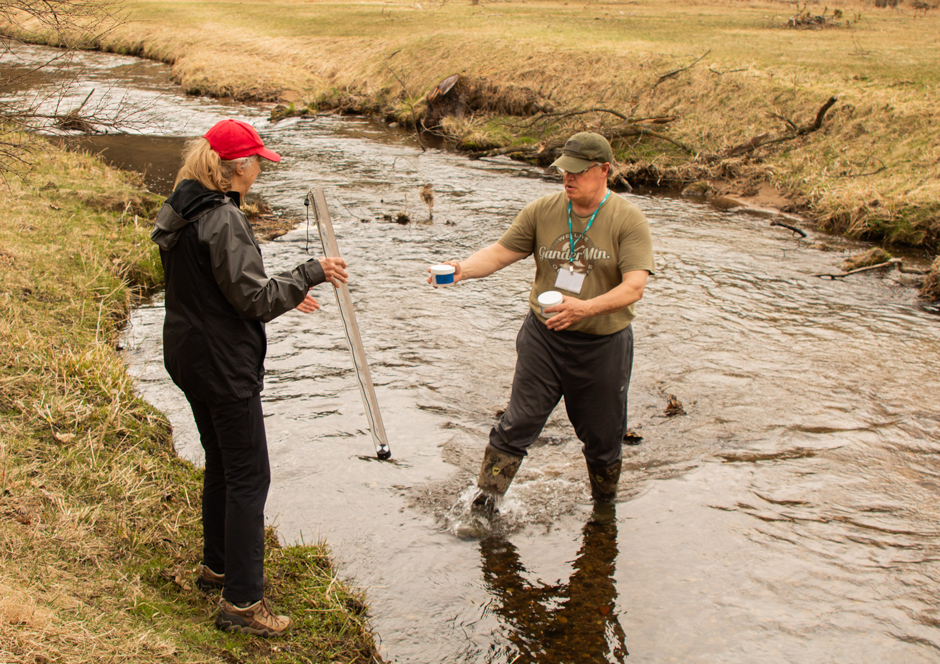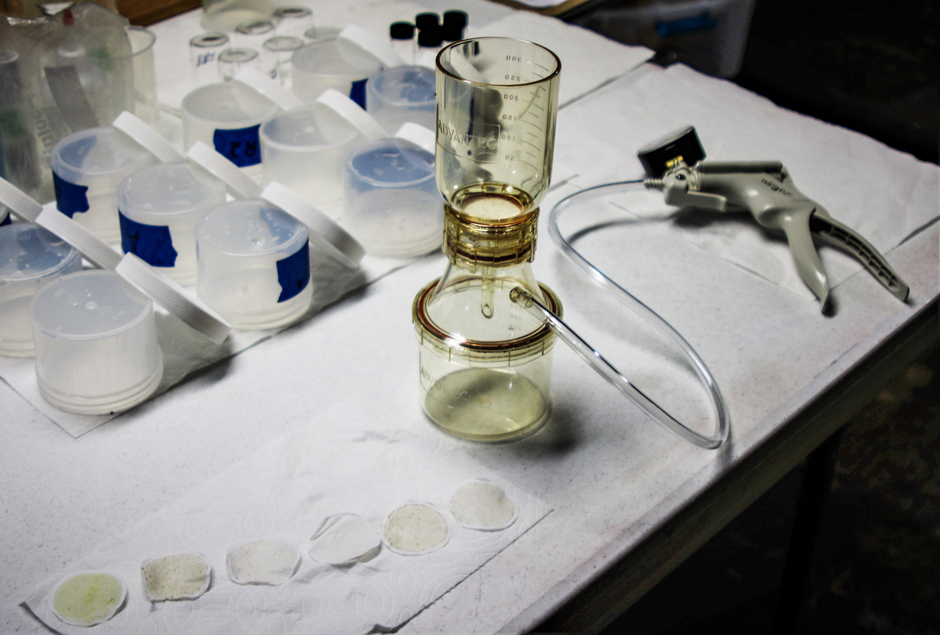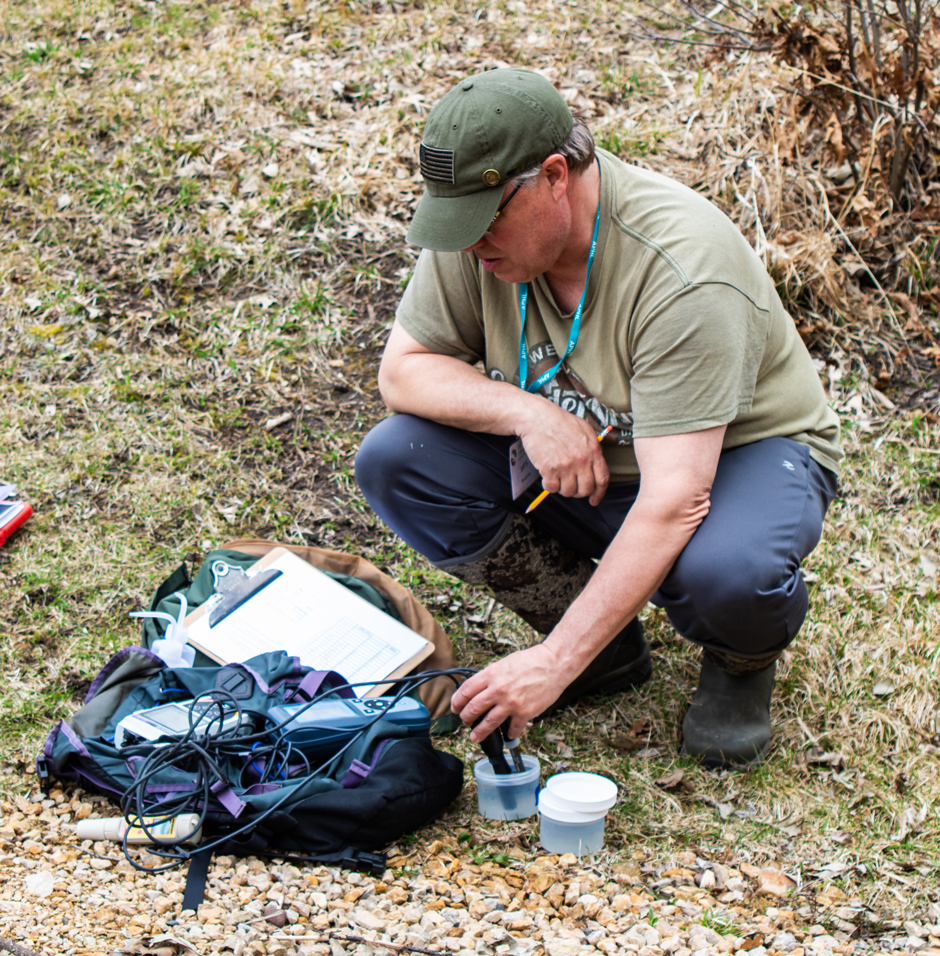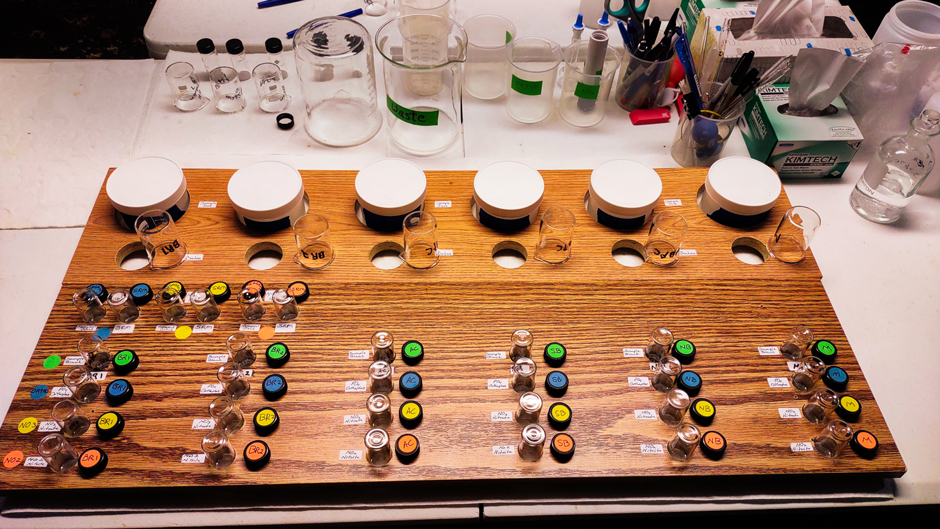Watershed Stewardship in Minnesota: Protecting Valley Creek in the Land of 10,000 Lakes
The Saint Croix Watershed is home to dozens of lakes, rivers, and streams that host an abundance of aquatic life from its tributaries. Valley Creek, a tributary of the St. Croix River, is a designated trout stream and while it is a pristine waterway, ongoing monitoring and stewardship establish a baseline of conditions and protect the creek.
Don Wendel and Dllona Clendenen, Minnesota Master Naturalists, Liberal Arts majors, and retired college teachers, are two members of the wetlands research team based out of the Science Museum of Minnesota’s St. Croix Watershed Research Station that monitors Valley Creek throughout the year.
They are joined by two other researchers, Jeffery Brenner, with the Inorganic Chemistry Unit, Minnesota Department of Health, and Lisa Peterson, a former chemistry professor retired from the University of Minnesota.

Clendenen and Brenner collecting two samples at each site. (Credit: Don Wendel / St. Croix Watershed Research Station)
From Bogs to Creeks: Wetland Research in Valley Creek
After spending several years researching the causes of flora change in Bernie’s Bog at Warner Nature Center, Wendel and Clendenen moved to Belwin Conservancy in Afton, Minnesota, in the spring of 2020. There, they were given space to establish their own laboratory, which gave them more rigorous control over research protocols.
While their research originally started in Metcalf Marsh, the group quickly determined that a more comprehensive study of the Valley Creek stream system was the best way to establish a definitive study.
Currently, the team oversees six sites starting where Valley Creek exits from Metcalf Marsh, through the confluence of the north and south branches, and close to the area where Valley Creek flows into the St. Croix River.
The team monitors the waterways to ensure that the ongoing development of the surrounding area does not impact the health of the watershed. The purpose of the monitoring is to establish a database that profiles typical artifacts for determining water quality.
“There are roads, homes, farms, and businesses around Valley Creek, and we were concerned that over time, there might be more development in the area. That development might affect the quality of Valley Creek, which is a designated trout stream and maintains five different kinds of trout in it,” states Wendel.
Valley Creek also sustains wildlife in the area. Otters, foxes, bears, birds, deer, and many other animals in the area would be impacted by deterioration of the creek.
He continues, “The goal of the monitoring program is to create a database against which we could measure any kind of dramatic change. For the few years we have been studying Valley Creek streams we have noticed an increase in the level of nitrate in the south branch of Valley Creek.”

Device used to filter samples for testing nitrate, nitrite, and orthophosphorous. (Credit: Don Wendel / St. Croix Watershed Research Station)
The frequent monitoring helps establish a highly granulated baseline of conditions at each site, and if any deterioration is recorded, the continuous sampling conducted by the team can help identify when, where, and why the change happened.
In order to create the database, the team goes out to the field twice a month and uses a Hach HQ2200 portable multimeter with dedicated probes to measure temperature, pH, conductivity, salinity, TDS, dissolved oxygen, and ORP.
For testing nitrate, nitrite, and orthophosphorus, a Hach DR900 colorimeter is used. Depending on the time of year and road conditions, the team will also use strips to test for chloride concentrations that might seep into the creek from road salt runoff.
Discharge of the river is also measured at each of the sites using a Global Water Flow Probe, and water clarity is measured using a Secchi tube.
The team also monitors precipitation as runoff from development could negatively impact water quality. Clendenen manages the precipitation equipment that continuously collects rain and snow over time, which can then be measured at a later site visit.

Brenner using the Hach DR900 to take conductivity readings. (Credit: Don Wendel / St. Croix Watershed Research Station)
Limitations and Challenges
While the team has been able to collect a significant pool of data over the years, there are limitations to expanding their work as well as daily challenges. Site visits can be disrupted due to weather events that present safety risks to fieldwork, and staffing has historically been an issue for the program.
Including Clendenen and Wendel, the ideal staff size of the program would be six people—however, the team is currently operating with only three full-time members.
Clendenen oversees the precipitation monitoring and analysis component of their research and also serves as Belwin’s contact for the program. She handles recruiting, schedules volunteers, and works in and out of the lab throughout the year.
Wendel manages the experimental aspects of the program. He monitors the experimental design, controls lab inventory, enters and analyzes data, and works with Clendenen to establish standard methods of sampling and analysis. Peterson and Brenner do both sample collection and testing. They also offer technical guidance when issues arise.
For analytes, like orthophosphorus, nitrite, and nitrate, the team tests against standards and seeks to test against a resulting standard that comes within 10% of true value of a standard. However, unstable standards, like the nitrate test, are a challenge for Wendel as they make results less reliable.
“We need to assure that our data gives an accurate profile of the health of Valley Creek if our program is to have credibility,” states Wendel.

Matrix used for testing samples from the six sites. (Credit: Don Wendel / St. Croix Watershed Research Station)
Future Potential of the Valley Creek Program
A larger staff would help things run more smoothly and allow for the program to expand its capabilities.
Clendenen’s precipitation monitoring, in particular, could be expanded on with some additional help. An extra researcher could assist with the data analysis, coordinating the precipitation data with what’s happening in the stream and noting any nutrient spikes or changes following weather events.
Wendel adds, “If we had the staffing, we could set up a program to better examine temperature changes in and during the various seasons.”
“There’s also concern PFAS may have polluted some of the groundwater. So, we could—if we had the money—we could expand our study of that and see how the creek has been affected by PFAs,” he continues.
Conclusion
The work being done by the wetlands research team is an essential part of protecting Valley Creek and the larger St. Croix watershed. The program is a key component of building consciousness about water quality in the surrounding region and better managing the area.
Clendenen explains, “Water is necessary for all life on our planet, and the quality of our water is degrading due to many factors, including, just for example, climate change and pollution.”
“We are working to monitor one pristine trout stream and ensure its continued positive impact on Valley Creek watershed and the St. Croix watershed into which its waters flow. We need to do all we can to protect the health of our climate. This is my reward,” she concludes.
In the grand scheme of things, the team’s work is only being conducted in one part of the watershed. However, both Clendenen and Wendel are hopeful that their work in Valley Creek will inspire other programs in the watershed.
“We would like to think that what we’re doing is a model and that somebody else could emulate that [elsewhere], and we would be happy to help them try to do that,” states Wendel.
If you are interested in joining the Valley Creek monitoring team or creating a program elsewhere in the St. Croix watershed, please contact Dllona Clandenen at dllonac@hotmail.com or Don Wendel at don_wendel@msn.com




0 comments